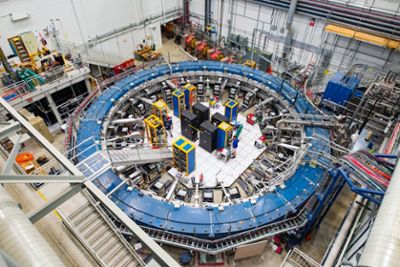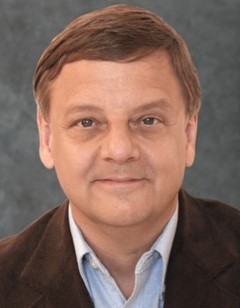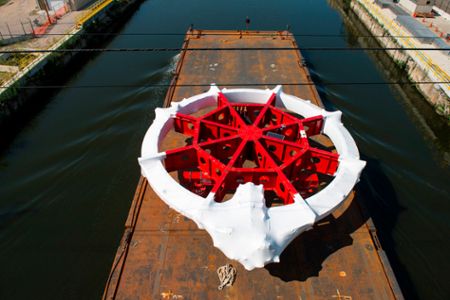Evidence of new physics: Unexpected behavior from fundamental particles
Michigan State University researchers have helped catch particles called muons behaving in a way that’s not predicted by the Standard Model of particle physics — the best theory that scientists have for explaining the universe’s fundamental particles and forces.
This deviation hints that there’s new physics yet to explore, such as undiscovered particles or forces.

“The first results from an experiment at Fermi National Accelerator Laboratory show strong evidence that our understanding of the subatomic world is incomplete,” said Martin Berz, a professor in the Department of Physics and Astronomy in MSU’s College of Natural Science. Fermilab, which is located near Chicago, is a U.S. Department of Energy Office of Science laboratory.
The results from this experiment, which is called the Muon g-2 experiment, confirm a discrepancy that has been gnawing at researchers for decades. The team published its landmark result in the journal Physical Review Letters on April 7.
Berz, a theoretical high energy physicist, is part of a team that’s 190 strong, representing 35 institutions from seven countries, probing fundamental physics with the power of Fermilab’s particle accelerators. The team’s Spartan contingent worked on precision beam dynamics calculations of the orbits of muons, which helped enable the Muon g-2 experiment to achieve unparalleled precision with its measurements.

“Collaboration was vital in this experiment,” Berz said. “The previously unattainable precision could only be achieved through the very tight interplay of the skills of many separate world-leading groups with different areas of expertise. It was great to see all the years of hard work on this project come to fruition.”
Michigan State’s other contributors include Kyoko Makino, a research professor in physics and astronomy, postdoctoral researcher Eremey Valetov, and graduate students Adrian Weisskopf and David Tarazona.
“Today is an extraordinary day, long awaited not only by us but by the whole international physics community,” said Graziano Venanzoni, co-spokesperson of the Muon g-2 experiment and physicist at the Italian National Institute for Nuclear Physics. “A large amount of credit goes to our young researchers who, with their talent, ideas and enthusiasm, have allowed us to achieve this incredible result.”
A muon is about 200 times as massive as its cousin, the electron. Muons occur naturally when cosmic rays strike Earth’s atmosphere. Fermilab’s particle accelerators can also produce the particles in large numbers.
Like electrons, muons act as if they have a tiny internal magnet. In a strong magnetic field, the direction of the muon’s magnet precesses, or wobbles, much like the axis of a spinning top or gyroscope. The strength of the internal magnet determines the rate that the muon precesses in an external magnetic field and is described by a number that physicists call the g-factor. This number can be calculated with ultra-high precision.

In the Muon g-2 experiment, muons circulate in a large magnetic storage ring. Within this ring, the muons also interact with a quantum foam of subatomic particles popping in and out of existence. Interactions with these short-lived particles affect the value of the g-factor, causing the muons’ precession to speed up or slow down very slightly. The Standard Model predicts this so-called anomalous magnetic moment extremely precisely. But if the quantum foam contains additional forces or particles not accounted for by the Standard Model, that would tweak the muon g-factor further.
“This quantity we measure reflects the interactions of the muon with everything else in the universe. But when the theorists calculate the same quantity, using all of the known forces and particles in the Standard Model, we don’t get the same answer,” said Renee Fatemi, a physicist at the University of Kentucky and the subsystem manager for the Muon g-2 experiment. “This is strong evidence that the muon is sensitive to something that is not in our best theory.”
The predecessor experiment at the Department of Energy’s Brookhaven National Laboratory, which concluded in 2001, offered hints that the muon’s behavior disagreed with the Standard Model. The new measurement from the Muon g-2 experiment at Fermilab strongly agrees with the value found at Brookhaven and diverges from theory with the most precise measurement to date.
The Fermilab experiment reuses the main component from the Brookhaven experiment, a 50-foot-diameter superconducting magnetic storage ring. In 2013, it was transported 3,200 miles by land and sea from Long Island to the Chicago suburbs, where scientists could take advantage of Fermilab’s particle accelerator and produce the most intense beam of muons in the United States.
“After the 20 years that have passed since the Brookhaven experiment ended, it is so gratifying to finally be resolving this mystery,” said Fermilab scientist Chris Polly, who is a co-spokesperson for the current experiment and was a graduate student on the Brookhaven experiment.
“So far we have analyzed less than 6 percent of the data that the experiment will eventually collect. Although these first results are telling us that there is an intriguing difference with the Standard Model, we will learn much more in the next couple of years,” Polly said.
“Pinning down the subtle behavior of muons is a remarkable achievement that will guide the search for physics beyond the Standard Model for years to come,” said Fermilab Deputy Director of Research Joe Lykken. “This is an exciting time for particle physics research, and Fermilab is at the forefront.”
Banner image: The Muon g-2 magnet ring sits in its detector hall amidst electronics racks and other equipment. The experiment operates at negative 450 degrees Fahrenheit. Courtesy of Fermilab.